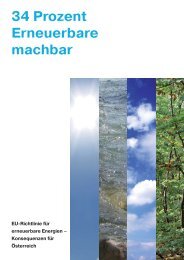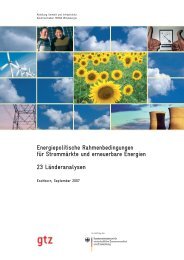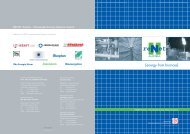K u rzfassu n g sb an d - Graz University of Technology
K u rzfassu n g sb an d - Graz University of Technology
K u rzfassu n g sb an d - Graz University of Technology
- Keine Tags gefunden...
Erfolgreiche ePaper selbst erstellen
Machen Sie aus Ihren PDF Publikationen ein blätterbares Flipbook mit unserer einzigartigen Google optimierten e-Paper Software.
Energieinnovation 2006 171<br />
6.4 Biomasse und Abfälle (Session F1)<br />
6.4.1 „The development <strong>of</strong> biomass markets in CEE“<br />
Jaroslav Knápek (Czech Technical <strong>University</strong> in Prague/FEL) 1 ,<br />
J<strong>an</strong> Weger (Vukoz) 2 ,<br />
Reinhard Haas, Lukas Kr<strong>an</strong>zl (TU-Wien/Energy Economics Group) 3<br />
Currently, a variety <strong>of</strong> Europe<strong>an</strong> policy targets are focussing on increasing the share <strong>of</strong> renewable<br />
energy. A major part <strong>of</strong> this share will be based on biomass. The inclining biomass use will lead to <strong>an</strong><br />
emerging biomass market, which partly will be a cross-border market. In particular the biomass use in<br />
central <strong>an</strong>d eastern Europe countries will be strongly influenced between countries <strong>an</strong>d <strong>of</strong> course the<br />
policy instruments focussing on biomass will strongly influence this development.<br />
This paper deals especially with the development <strong>an</strong>d prospects <strong>of</strong> biomass market in Austria <strong>an</strong>d the<br />
Czech Republic considering the development in whole CEE. The core questions investigated in this<br />
paper are:<br />
• Which promotion schemes for bioenergy are currently implemented in central Europe<strong>an</strong><br />
countries<br />
• What is the current state <strong>of</strong> biomass use in these countries<br />
• What are the potentials, prospects <strong>an</strong>d barriers for biomass development in these countries<br />
• Which conclusions c<strong>an</strong> be derived for the future biomass market development <strong>an</strong>d which<br />
measures should be taken<br />
This paper provides a comparative survey about promotion schemes in Austria, the Czech Republic<br />
<strong>an</strong>d other central eastern Europe<strong>an</strong> countries. Biomass markets, potentials <strong>an</strong>d dem<strong>an</strong>d for biomass<br />
resources are investigated. Moreover, prospects for the biomass market in the Czech Republic <strong>an</strong>d<br />
Austria are carried out.<br />
The comparative investigation <strong>of</strong> promotion schemes shows that in the field <strong>of</strong> electricity generation<br />
from biomass, the dominating instrument in the considered countries is a feed-in-tariff. Comparing the<br />
level <strong>of</strong> feed-in-tariff it turns out that in Austria <strong>an</strong>d Germ<strong>an</strong>y the incentives are signific<strong>an</strong>tly higher (in<br />
the r<strong>an</strong>ge <strong>of</strong> 8-16 c/kWh) th<strong>an</strong> in the other countries (about 3 to 8 c/kWh). Moreover, in Germ<strong>an</strong>y <strong>an</strong>d<br />
Austria a stronger distinction is made between various fuels <strong>an</strong>d size <strong>of</strong> pl<strong>an</strong>ts.<br />
In the bioheat sector, the most import<strong>an</strong>t promotion schemes in all countries are subsidies, partially<br />
combined with tax incentives <strong>an</strong>d s<strong>of</strong>t lo<strong>an</strong>s. However, the comparison <strong>of</strong> the level <strong>of</strong> subsidy is not<br />
straightforward since there are <strong>of</strong>ten additional requirements <strong>an</strong>d restrictions like maximum level <strong>of</strong><br />
support, maximum available budget etc.<br />
For bi<strong>of</strong>uels in the tr<strong>an</strong>sport sector, the most dominating instruments are tax exemptions <strong>an</strong>d the<br />
bi<strong>of</strong>uel directive <strong>of</strong> the EU. Thus, <strong>an</strong> import<strong>an</strong>t parameter is the level <strong>of</strong> taxation <strong>of</strong> fossil fuels. The<br />
comparison between these countries shows that Germ<strong>an</strong>y has signific<strong>an</strong>tly higher taxes on gasoline<br />
<strong>an</strong>d diesel as the other countries. Among the others, taxation is especially low in Croatia <strong>an</strong>d Pol<strong>an</strong>d,<br />
<strong>an</strong>d for diesel also in Austria.<br />
1 Czech Technical <strong>University</strong> in Prague, FEL; Technicka 2, 166 27 Praha 6, Czech rep.<br />
Tel: +420 224353315, Fax:+420 233334232; e-mail: knapek@fel.cvut.cz;<br />
2 VUKOZ, Kvetnove nam. 391, 252 43 Pruhonice, Czech rep.<br />
Tel: +420 296528267, Fax:+420267750440, e-mail: weger@vukoz.cz;<br />
3 Energy Economics Group, Institut für Elektrische Anlagen und Energiewirtschaft,<br />
Technische Universität Wien, Gußhausstraße 25-29/373-2, 1040 Wien<br />
Tel: +43 1 58801/37351, Fax: +43 1 58801/37397, e-mail: Lukas.Kr<strong>an</strong>zl@tuwien.ac.at;





